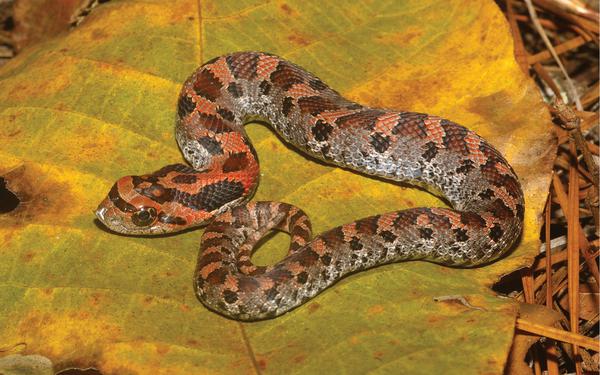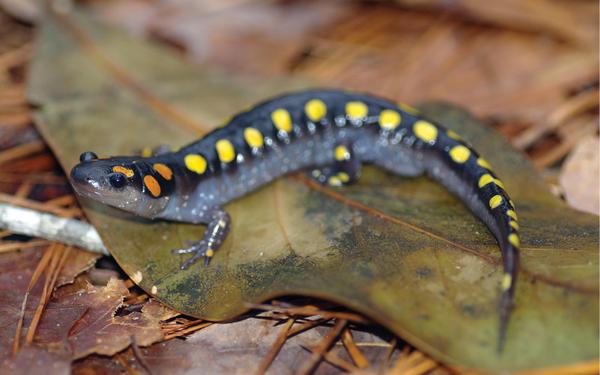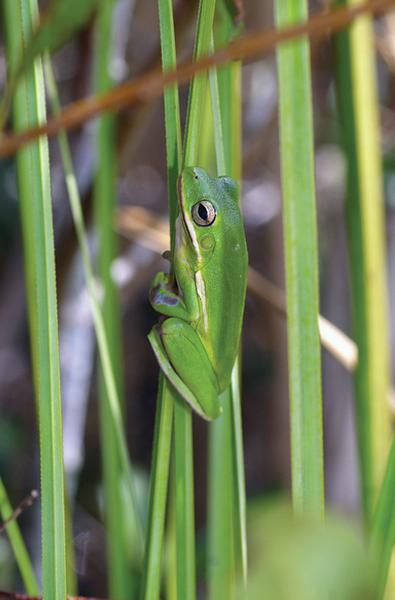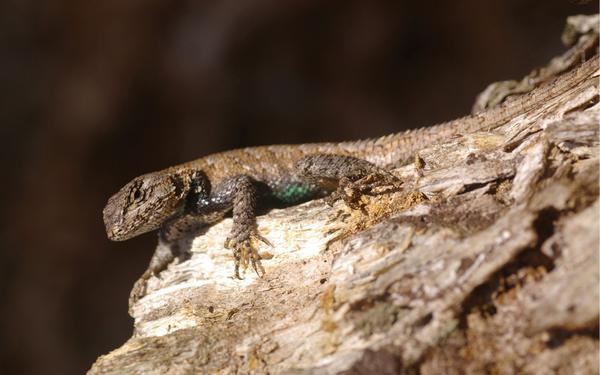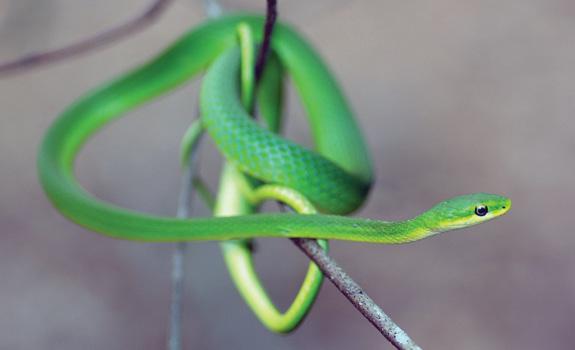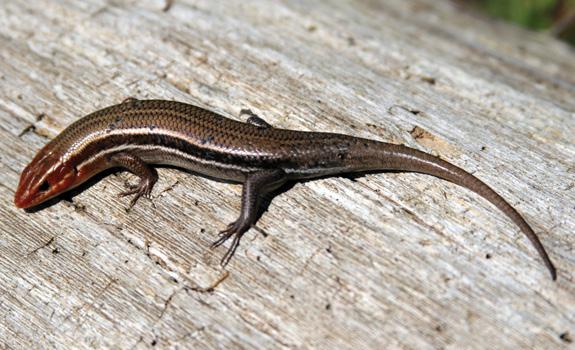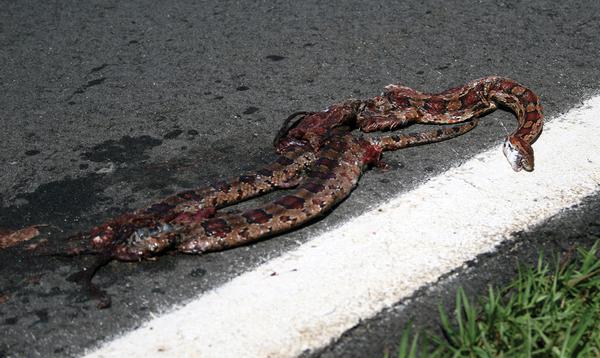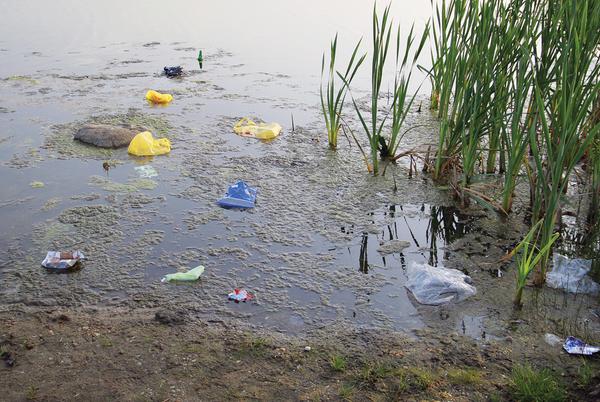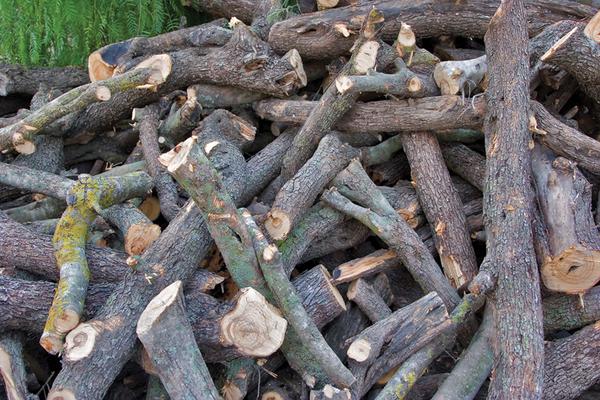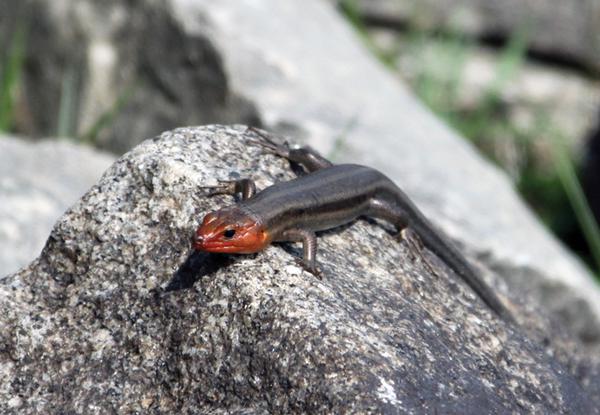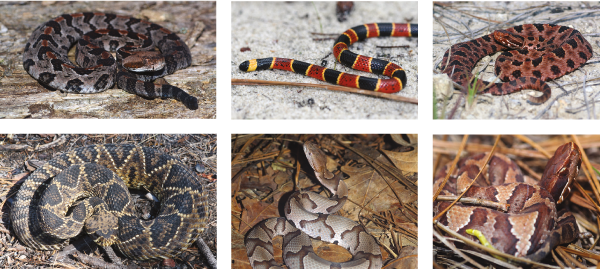On a warm North Carolina spring night, after a refreshing rain, you may be serenaded by the most boisterous of symphonies. Northern and southern cricket frogs are the percussion section, and Cope’s gray treefrogs add their melodic, soprano trills. Green frogs pluck banjo strings, while Fowler’s toads add their rhythmic singsong. It is a wildlife chorus unequaled outside of the southeastern United States, which boasts more than half of the country’s reptile and amphibian species. Indeed, more than 100 species of reptiles and amphibians found in this region occur nowhere else in the world.
Amphibians and reptiles are an important part of the rich ecological heritage of North Carolina, and they play important roles in North Carolina’s ecosystems. As urban development continues to expand across the state, it is important that North Carolina citizens recognize the value of reptile and amphibian populations and learn how to conserve their habitats.
The Lives of Amphibians and Reptiles
Scientists combine amphibians and reptiles in a group called herpetofauna, or herps for short. This name comes from the word herpetology, which is the scientific study of reptiles and amphibians. Why combine reptiles and amphibians in the same group? It’s because they share some common characteristics. Unlike mammals and birds, many herps (along with fish) are ectotherms. Ectotherms (commonly called “cold-blooded animals”) do not rely on their metabolism or other bodily processes (such as sweating and shivering) to maintain a constant body temperature. Instead, ectotherms use behavior and the environment to regulate their body heat. For example, some of the more easily seen herps are pond turtles basking on logs and lizards sunning on fence posts or porch railings to raise their body temperatures. Conversely, a reptile or amphibian might slip into a shady pond to cool down.
Although basking turtles and lizards are fairly common sights, certain behaviors of ectotherms can make herps more difficult to find. Some hibernate during cold weather, which drastically slows down their body processes, and remain dormant and hidden until temperatures rise. Other herps aestivate (a behavior like hibernation) during hot, dry times when moving around might cause them to overheat.
Even when temperatures are favorable, reptiles and amphibians often remain hidden from view. Frogs such as the American bullfrog (Figure 1) spend much time in the water, where they quickly submerge when startled. Many snakes, such as the eastern hognose snake (Figure 2), box turtles, and toads are well camouflaged and blend easily into the colors of the forest floor. Salamanders dwell under logs, leaves, and rocks. Because ectothermic animals do not expend energy to regulate their body temperatures, they eat less often than endotherms, and are less likely to be seen foraging.
Herps in the Ecosystem
Herps play important roles in the ecosystems where they live. Some are predators that keep numbers of their prey in check. Examples include salamanders that eat insect larvae or snakes that eat mice and other rodents. Herps are found on the other end of the food chain as well; frogs are important prey for many species of fish, birds, mammals, and reptiles.
Herps can also serve as good indicators of environmental health. A healthy, diverse herp community indicates that an area can support the plants and insects that herps need for food and that the area provides habitat for a variety of other wildlife. The absence of herps from an area where one would expect to find them can indicate an environmental problem.
Amphibians and reptiles have many similarities, but they also have some big differences. Let’s explore those now.
Amphibians
Amphibians include salamanders, frogs, and toads. Typically, amphibians eat insects and other small invertebrates. Some larger species eat small vertebrates, including fish, other amphibians, and small birds. Many tadpoles (the fully aquatic larval form of frogs and toads) eat mostly plants.
Amphibians’ skin is permeable, which means it is not a solid barrier between the environment and the insides of their bodies. Permeable skin allows amphibians to absorb oxygen and release carbon dioxide (in other words, respire) through their skin. The skin must remain moist for this process to work. Permeable skin is not the only way that amphibians breathe. They might have lungs similar to mammals or birds, gills similar to fish, or a combination of permeable skin, lungs, or gills for breathing. Many amphibians use different methods of breathing throughout their lives, depending on their stage of development.
The drawback of having permeable skin is that toxins and pollutants from the environment can pass through the skin and into an animal’s body. Toxins and pollutants might disrupt the animal’s development or reproduction, or even kill the animal. This is one reason the presence of amphibians is an important indicator of environmental health—many species cannot survive and reproduce in polluted water.
As a group, amphibians have complex, varied life histories. Frogs and some salamanders, like the spotted salamander (Figure 3), lay eggs in water. Their young hatch as aquatic larvae, but live their adult lives on land or a combination of land and water. Some amphibians (especially some salamander species) lay eggs on land in moist places. Amphibians’ eggs do not have shells, and, like adult amphibians, they are vulnerable to pollutants.
Different species of amphibians need specific environmental conditions based on their own life histories. In general, to survive in an area, amphibians need:
- Access to aquatic or wet sites (pools, ponds, streams, seeps where water comes to the surface, or marshes) to lay eggs, and in some cases, to live as adults.
- Access to terrestrial sites (dry land) for adult life, breeding, and movement between aquatic environments.
- Access to shelter (damp, rotting logs and stump holes) to protect them from predators and weather, and to keep their skin moist.
Amphibians Common to Urban/Suburban Areas
Frogs and Toads
American toad Anaxyrus americanus
Fowler’s toad Anaxyrus fowleri
Southern toad Anaxyrus terrestris
Northern cricket frog Acris crepitans
Southern cricket frog Acris gryllus
Cope’s gray treefrog Hyla chrysoscelis
Green treefrog Hyla cinerea (Figure 4)
Squirrel treefrog Hyla squirella
Spring peeper Pseudacris crucifer
Upland chorus frog Pseudacris feriarum
Eastern narrowmouth toad Gastrophryne carolinensis
American bullfrog Lithobates catesbeianus
Green frog Lithobates clamitans
Pickerel frog Lithobates palustris
Southern leopard frog Lithobates sphenocephalus
Salamanders
Marbled salamander Ambystoma opacum
Spotted salamander Ambystoma maculatum
Eastern newt Notophthalmus viridescens (Figure 5)
Southern two-lined salamander Eurycea cirrigera
Blue Ridge two-lined salamander Eurycea wilderae
Northern dusky salamander Desmognathus fuscus
White-spotted slimy salamander Plethodon cylindraceus
Atlantic Coast slimy salamander Plethodon chlorobryonis
Reptiles
Reptiles include snakes, lizards, turtles, and crocodilians. Unlike amphibians, reptiles have scaly, impermeable skin that does not need to stay moist. All reptiles use lungs to breathe.
The reptilian diet varies widely among groups and species, and can include small vertebrates (such as birds, mice, and frogs), invertebrates (insects and crustaceans), and plants. Most reptiles lay leathery-shelled eggs on dry land, but some snakes (especially aquatic and semi-aquatic species) give birth to live young.
In general, to survive in an area, reptiles need:
- Access to basking sites to warm in the sun or absorb heat from a surface that has been warmed by the sun (such as a log) (Figure 6).
- Access to shelter, such as trees, leaf litter, shrubs, downed logs, or snags (standing dead trees) to cool off, hide from predators, and ambush prey.
- Access to hibernacula (shelter), often stump holes or crevices under rocks or logs, to hibernate through the winter.
- For aquatic turtles, alligators, and some aquatic snakes: access to a safe, dry, land buffer along the water’s edge to lay eggs.
Reptiles Common to Urban/Suburban Areas
Snakes
Worm snake Carphophis amoenus
Black racer Coluber constrictor
Ringneck snake Diadophis punctatus
Corn snake Pantherophis guttatus
Rat snake Pantherophis alleghaniensis
Eastern hognose snake Heterodon platirhinos
Eastern kingsnake Lampropeltis getula
Rough green snake Opheodrys aestivus (Figure 7)
Eastern garter snake Thamnophis sirtalis
Copperhead Agkistrodon contortrix
Rough earth snake Virginia striatula
Turtles
Common snapping turtle Chelydra serpentina
Painted turtle Chrysemys picta
Eastern box turtle Terrapene carolina (Figure 8)
Yellowbelly slider Trachemys scripta
Lizards
Green anole Anolis carolinensis
Eastern fence lizard Sceloporus undulatus
Five-lined skink Plestiodon fasciatus
Broadhead skink Plestiodon laticeps
Southeastern five-lined skink Plestiodon inexpectatus (Figure 9)
Herps in Developed Areas
Before considering how to share our land with reptiles and amphibians and to protect them, we must understand how human activities might threaten their populations. Armed with this information, we can manage and use the land in harmony with the needs of wildlife.
North Carolina’s human population is rapidly expanding, especially in the urban and suburban areas. The biggest threats to herps from development include traffic hazards, pollution, and habitat loss and fragmentation (Figure 10, Figure 11, and Figure 12).
Habitat Loss and Fragmentation
Habitat is lost when a natural area is converted into a developed area that herps can no longer use. Filling in low-lying areas to level the land eliminates the pools used for breeding, hiding, or cooling off. Clearing forests removes sheltering trees, leaves, shrubs, and access to shelter areas that protect animals and provide safe nesting and hibernation sites.
Habitat is fragmented when roads, neighborhoods, shopping centers, or other developments divide them. Fragmentation increases risks exposure to predators, vehicles, and the weather as herps move between the smaller patches of habitat. Development that isolates a lake, pond, or stream from drier areas or disturbs high quality habitat can increase mortality rates for herps.
Traffic Hazards
Nearly everyone has seen an eastern box turtle whose shell was crushed as it tried to cross a highway. Snakes basking on roads and frogs that are leaving their birth ponds also are frequent victims of vehicles. Herps have nearly no chance of surviving a trip across a heavily traveled (15,000 vehicles/day) road.
Sedimentation and Pollution
Sedimentation occurs when rain washes sediment such as dirt or silt into streams or other wetlands. Sedimentation increases during construction because exposed dirt erodes easily during rainstorms. After construction is complete, rainwater runs quickly across impervious surfaces such as concrete, asphalt, or buildings, and carries sediment and debris into nearby bodies of water. Sedimentation clouds the water and fills hiding places between rocks. Animals cannot get the oxygen and food they need from the muddy water, and the plants they eat cannot survive.
In addition to washing sediment into streams, rainwater washes toxins, such as insecticides, herbicides, fertilizers, and petroleum products, into waterways and low-lying wetlands. Toxins poison amphibians directly through their permeable skin or eggs, and herps that eat contaminated prey become sick. Fertilizers that are washed into ponds and streams can cause algal blooms that make laying eggs impossible for amphibians, reduce the amount of oxygen in the water, and kill the invertebrates that amphibians eat. Insecticides reduce herps’ food supply, because insects are much of the prey for both reptiles and amphibians.
Sharing the Land with Amphibians and Reptiles
Creating a Backyard Habitat
You can do a lot to help conserve herp populations right in your own backyard. You can help by planning for wildlife when you decide how to manage your lawn and garden. Many of the practices that will make your backyard attractive to herps will also attract other wildlife such as birds and butterflies.
Part of managing your yard for herps requires creating or improving habitat. To help provide for herps’ habitat needs, you can:
- Add a pool or pond (see Adding a Water Feature). Include native plants such as pickerelweed (Pontederia cordata), but do not add fish, because they will eat amphibian eggs and larvae. If you are concerned about mosquitoes, you can use treatments available at gardening stores that contain a chemical named Bt-israelensis (Bt-i) and are marketed as Mosquito Dunks. These tablets are added to pools or other standing water to prevent mosquito larvae from surviving, and they do not harm other wildlife. Dragonflies are predators of mosquitoes. Planting underwater vegetation where dragonfly nymphs can hide and plants where adult dragonflies can perch and lay eggs will help attract them to your pool. Some salamander larvae also prey on mosquito larvae.
- Select native species for your garden. Native wildlife species survive best when surrounded by plants that are native to the region where they live. Non-native plants, especially those that grow uncontrolled, can disrupt the natural ecosystem in your yard. For information on the importance of native plants to wildlife, visit the Wildlife Friendly Landscapes website.
- Provide shelter (see Providing Shelter for Herps). Providing shelter for herps can involve building a structure or simply not removing the shelter already in place. Dead trees, stumps, and taller herbaceous plants (forbs, or broad-leafed plants, and grasses) provide good protection for herps. Consider building rock piles or walls near a pond, pool, or wet area to provide both shelter and basking sites. Brush piles placed on dry land near a tree, bush, or thicket are readily used by herps—just be sure not to include any chemically-treated wood.
Adding a Water Feature
A water feature like the one in Figure 13 is excellent habitat for herps that provides water and a rock wall for shelter. Keep in mind, however, that an elaborate water feature is not necessary. A large trashcan filled with rainwater will attract tree frogs in the spring. If you choose to build a mini-pond, keep these ideas in mind:
- Try to choose a location within ½ mile of another pond or pool and in a place where animals can move safely back and forth between the ponds.
- Position the pool so that it has sunny and shady areas. This way the pool will not get too warm, but will provide basking sites on exposed logs, floating plants, or rocks.
- Use a flexible liner or a plastic pre-formed pool to prevent the water from soaking into the ground.
- Deeper (30 inches or more) water may be necessary to ensure the entire pond does not freeze in the winter, which would kill dormant animals.
- Provide wide, shallow areas for easy entrance and exit by animals, and deep areas for hiding places and aestivation, or slowing of activity during the summer.
- Include native plants, rocks, and branches that are placed in or along the edge of the water.
- Place aquatic plants in underwater pots so that their growth can be confined.
- Algae may bloom in a newly established pool or pond. In a month or two, the ecosystem should come into balance. Be sure to keep all nutrients and fertilizers out of the water to prevent excessive algae.
- Allow some dead leaves and other debris to settle in the bottom of the pool to provide shelter and breeding sites.
- Native plants and other natural features (dead vegetation, snags, which are dead or dying standing trees, and logs) provide great cover for wildlife. Other features you can add include brush piles, rock piles, and amphibian houses.
Good habitat will be wasted if your yard is unsafe for herps. To reduce hazards to herps, you should:
- Limit chemical use. Remember that storm drains lead directly to streams. Apply herbicides, insecticides, and fertilizers only in the smallest amounts necessary and only when absolutely needed. Always follow the instructions on the label. Avoid using any chemicals near water sources and storm drains, unless labeled for such use. Rinse excess or spilled fertilizer off your driveway onto the lawn so that it does not wash into storm drains when it rains. If your car is leaking oil, repair it and clean up the spill so that the oil does not wash into streams.
- Control household pets that might harm herps or their habitats. Outdoor cats and dogs prey on lizards and a variety of other wildlife. Studies have shown that up to 90% of the diet of outdoor domestic cats might be wild animals. Dogs trample leaves and disturb garden pools. Keep your cat indoors and restrict your dog from newly created habitat to maintain healthy herp populations in your yard.
Providing Shelter for Herps
Log and Brush Piles (Figure 14)
- Firewood or logs stacked in an organized arrangement provide shelter.
- Brush piles include a variety of sizes of sticks and limbs and are not as orderly as log piles.
- Larger diameter logs should be placed on the bottom to create hiding places. Criss-cross smaller branches on top, and add a native flowering vine such as Carolina jessamine (Gelsemium sempervirens) to cover the pile.
- A finished dome-shaped brush pile about 5 feet wide at the base provides effective shelter for a variety of wildlife species.
Rock Piles (Figure 15)
- Place larger stones on the bottom to create pockets and caves. You can add PVC pipe to create tunnels.
- Make a rock wall (a long, narrow rock pile) that will provide shelter and a protected corridor for travel.
- Place rocks in a sunny area to provide basking sites for turtles, snakes, lizards, and butterflies.
Amphibian Houses (Figure 16)
- Children may enjoy creating houses for amphibians from upside-down clay flower pots that have a small section of the lip cracked off for a door. Place these in a shady section of the yard for toads and salamanders.
- A larger shelter can be constructed by digging a 2-inch-deep depression in a shady area and covering it with a piece of untreated plywood. Prop one side of the plywood up with fist-sized rocks to provide an entrance. You can cover the plywood with mulch or old leaves, and plant native wildflowers around it.
After you have created food and cover for amphibians and reptiles, wait for them to arrive naturally. Never move herps from the wild to your yard. It may take several months for them to start appearing—and that may be longer if you are farther away from other habitat.
You can view your new backyard inhabitants with binoculars, especially close-focusing binoculars, and you may notice signs of herps such as shed skins or eggshells. Most of the time, you can learn a lot by viewing from a distance, but taking a close-up look is very interesting, especially for children. If you choose to handle herps you find in your yard, do so with great care. Handling an animal risks injury or, in the case of amphibians, exposing the animal to chemicals you might have on your hands from soap, lotion, or insect repellant. Some species can inflict injuries from bites or scratches if they are handled carelessly.
A note about venomous snakes. North Carolina is home to six venomous snake species: timber rattlesnake, eastern coral snake, pigmy rattlesnake, cottonmouth, copperhead, and eastern diamondback rattlesnake (Figure 17). Copperheads are the most common backyard venomous snakes in North Carolina. They are secretive and are typically not aggressive, and they pose a threat only if provoked. If you find a venomous snake in your yard, keep pets and small children who might disturb the snake away from the area where it was seen and leave it alone.
Thinking Beyond Your Backyard: Neighborhood and Greenspace Development
You don’t have to limit your desire to share the land with herps to your own backyard. Encourage your neighborhood, community, or town to engage in responsible, wildlife-sensitive development. Urge developers to limit chemical use and landscape with native plants. Other wildlife-friendly practices that developers can incorporate into their plans include:
- Protect seasonal wetlands during construction. Undisturbed, low-lying areas that are seasonally wet are particularly important for herps. These temporary pools often stay wet just long enough for the aquatic larvae of many frogs, toads, and salamanders to hatch and change into terrestrial adults. There are no fish in these pools that might eat amphibian eggs, so they are relatively safe places to lay eggs. These pools provide a good prey base of insects and vegetation.
- Do not disturb buffer zones adjacent to wetlands. Protecting uplands next to streams and wetlands is important so that many turtles and other pond-dwelling herps can safely lay their eggs out of the water. Many salamanders that lay their eggs in temporary pools live in the adjacent uplands during most of the year.
- Leave or create safe corridors between habitat patches. Amphibians need both wet and dry sites, and they need to be able to move back and forth freely between these areas. Reptiles need to be able to disperse to mate and breed. Corridors between habitat patches should not be intersected by roads, should have adequate cover, and are most effective if they are at least 300 feet wide.
- Reduce potential for road mortality. Community planners should reduce speed limits, install speed bumps, and put up signs alerting drivers where herps and other wildlife are likely to cross roads. Installing fences and culverts or amphibian tunnels can help route reptiles and amphibians safely under a roadway. Avoid new road construction around critical herp breeding wetlands.
- Minimize sedimentation. During development, construction workers should leave the soil as undisturbed as possible. Disturbed and compacted soil disrupts habitat for fossorial species (species that live underground) and increases erosion. If installed properly, sediment-catching silt fences can be helpful during construction.
- Protect streamside vegetation during development. Leaving streams intact and stream banks un-mowed provides cover and helps filter sediment and toxins out of the water before they enter streams and other wetlands.
The next time you hear the symphony of frogs greet you on a warm evening, you will have a better appreciation of the amazing lives of the diverse amphibians and reptiles that live here in North Carolina. Even more importantly, you will know some simple, enjoyable, and effective steps that you can take to ensure that the symphony continues year after year.
For More Information
Amphibians and Reptiles of North Carolina
Barnes, Thomas G. 1999. Gardening for the Birds. Lexington, KY: University of Kentucky.
Beane, Jeffrey C., Alvin L. Braswell, Joseph C. Mitchell, William M. Palmer, and Julian R. Harrison III. 2010. Amphibians and Reptiles of the Carolinas and Virginia. Chapel Hill, NC: University of North Carolina Press.
Buhlmann, Kurt, Tracey Tuberville, and Whit Gibbons. 2008. Turtles of the Southeast. Athens, GA: University of Georgia Press.
Conant, Roger, and Joseph T. Collins. 1998. A Field Guide to Reptiles and Amphibians: Eastern and Central North America. Boston, MA: Houghton Mifflin.
Gibbons, Whit, and Mike Dorcas. 2015. Snakes of the Southeast, Revised Edition. Athens, GA: University of Georgia Press.
Gibbons, Whit, Judy Greene, and Tony Mills. 2009. Lizards and Crocodilians of the Southeast. Athens, GA: University of Georgia Press.
Mitchell, Joe, and Whit Gibbons. 2010. Salamanders of the Southeast. Athens, GA: University of Georgia Press.
Mizejewski, David. 2004. Attracting Birds, Butterflies and Other Backyard Wildlife. Upper Saddle River, NJ: Creative Homeowner.
Moorman, Chris, and Jeffrey Pippen, et al. 2021. Butterflies in Your Backyard. AG-636-02. NC State Extension.
Moorman, Chris, Mark Johns, Liessa Thomas Bowen, and John Gerwin. 2022. Managing Backyards and other Urban Habitats for Birds. AG-636-01. NC State Extension.
Moorman, Chris, Mark Johns, Liessa Thomas Bowen, et. al. 2022. Landscaping for Wildlife with Native Plants. AG-636-03. NC State Extension.
North Carolina Partners in Amphibian and Reptile Conservation
Palmer, William M., and Alvin L. Braswell. 1995. Reptiles of North Carolina. Chapel Hill, NC: University of North Carolina Press.
Publication date: Aug. 25, 2022
AG-744
N.C. Cooperative Extension prohibits discrimination and harassment regardless of age, color, disability, family and marital status, gender identity, national origin, political beliefs, race, religion, sex (including pregnancy), sexual orientation and veteran status.


